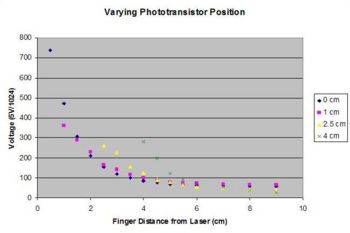Difference between revisions of "Fingertip laser light sensor"
| Line 4: | Line 4: | ||
== Overview == |
== Overview == |
||
| ⚫ | |||
A laser that emits a sheet of laser light and phototransistor were the main components of this lab. They are used to investigate a fingertip position sensor that senses the position of the finger based on reflected laser light. The laser is positioned so that it emits a sheet of light just above the plane of the table. If a finger is placed within this field of light, then it will reflect the light back towards the laser. A phototransistor was used to detect the light reflected from the finger. A sensor circuit was designed to take analog voltage readings from the phototransistor with the intention of relating the intensity of reflected light to both the (1) finger position and (2) the phototransistor's location relative to the emitter. The results were displayed by communicating with a PC. |
A laser that emits a sheet of laser light and phototransistor were the main components of this lab. They are used to investigate a fingertip position sensor that senses the position of the finger based on reflected laser light. The laser is positioned so that it emits a sheet of light just above the plane of the table. If a finger is placed within this field of light, then it will reflect the light back towards the laser. A phototransistor was used to detect the light reflected from the finger. A sensor circuit was designed to take analog voltage readings from the phototransistor with the intention of relating the intensity of reflected light to both the (1) finger position and (2) the phototransistor's location relative to the emitter. The results were displayed by communicating with a PC. |
||
| ⚫ | |||
Data from several situations involving different positionings of the laser, phototransistor, and fingertip was taken. |
Data from several situations involving different positionings of the laser, phototransistor, and fingertip was taken. |
||
Revision as of 00:26, 12 February 2009
Original Assignment
I will provide you with a laser that emits a sheet of laser light and a phototransistor for detecting this light. You will investigate their use in developing a fingertip position sensor that senses distance to the finger based on reflected laser light. Your job is to design a sensor circuit and determine the analog voltage readings you get as a function of (1) your finger position and (2) the sensor's location relative to the emitter. You will likely display your results by communicating with a PC or by writing to an LCD (see, e.g., C Example: Serial LCD or C Example: Parallel Interfacing with LCDs).
Overview
A laser that emits a sheet of laser light and phototransistor were the main components of this lab. They are used to investigate a fingertip position sensor that senses the position of the finger based on reflected laser light. The laser is positioned so that it emits a sheet of light just above the plane of the table. If a finger is placed within this field of light, then it will reflect the light back towards the laser. A phototransistor was used to detect the light reflected from the finger. A sensor circuit was designed to take analog voltage readings from the phototransistor with the intention of relating the intensity of reflected light to both the (1) finger position and (2) the phototransistor's location relative to the emitter. The results were displayed by communicating with a PC.
Data from several situations involving different positionings of the laser, phototransistor, and fingertip was taken.
Circuit
Code
Data
Finger in front of the laser and phototransistor (Resistors and Y distance from finger to laser/transistor varied)
Distance calibration using 19.5 K-Ohm resistor
Transistor next to laser (For certain Y distances, X coordinates varied)
Transistor in front of the laser (Y distance from transistor and laser varied)
Transistor next to laser (For certain X coordinates, Y distance varied)
Limitations and Environmental Factors
There were a few environmental factors that affect the sensors:
1) Ambient light: The overhead light saturated the phototransistor and so the laser was pulsed(the pic was programmed to strobe the laser) in an effort to provide a noticeable difference between the ambient and laser light. Before the laser was pulsed, a finger in front of the transistor cast a shadow which had a larger effect (due to the blocking of the ambient light)than the actual blocking of the laser. Any shadow cast on the sensors by a finger or head will affect the ambient light sensed by the phototransistor and should be taken into account.
2) Lower resistances can be used for the phototransistor to prevent saturation but this also causes a reduced sensitivity to light.
3) The sheet laser provided was not uniform. There were different intensities of light across the line emitted.
4) There is a limited range in which the fingertip laser light sensor is accurate. Using the code and setup described above, there was accurate sensing of the fingertip directly in front of the laser and phototransistor to about seven centimeters.





